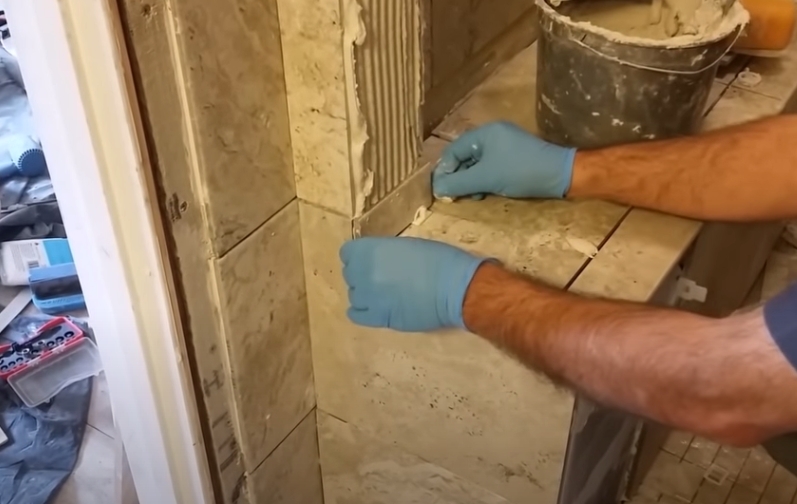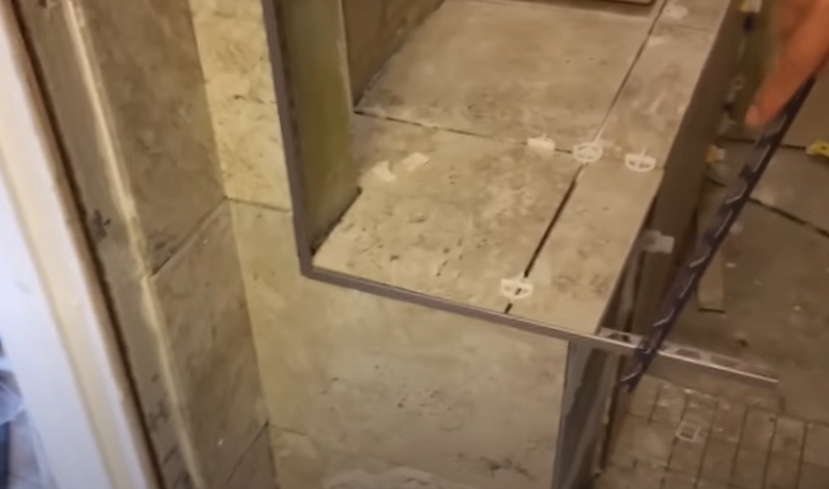Welcome to our guide on "5 Mistakes about Tiling Corners With Trim," where we delve into the intricacies of this essential yet often overlooked aspect of tile installation. In this article, we'll explore the significance of mastering corner tiling techniques and highlight common pitfalls that can compromise the outcome of your project.
Before we dive into the specifics, it's essential to understand why tiling corners with trim matters. Beyond aesthetics, properly executed corner tiling contributes to the structural integrity and longevity of your installation. It ensures seamless transitions between adjacent surfaces and prevents moisture infiltration, ultimately enhancing the durability and functionality of your tiled spaces.

Throughout this article, we'll identify five prevalent mistakes that DIY enthusiasts and seasoned professionals alike may encounter when tiling corners with trim. By shedding light on these common missteps, we aim to equip you with the knowledge and insights needed to avoid them and achieve impeccable results in your tiling endeavors.
So, whether you're a novice embarking on your first tiling project or a seasoned pro seeking to refine your techniques, join us as we uncover the nuances of tiling corners with trim and learn how to sidestep the pitfalls along the way. Let's dive in!
#1 Incorrect Measurement and Planning
Accurate measurement and thorough planning lay the foundation for a successful tiling project, especially when it comes to handling corners with trim. The slightest miscalculation can lead to visible gaps, uneven transitions, and compromised aesthetics.
One common error is misjudging the dimensions of trim pieces. Whether it's underestimating the required length of trim or failing to account for corner angles, overlooking these details can result in ill-fitting trim that detracts from the overall finish.
- Inadequate planning for corner transitions is another pitfall to avoid. Neglecting to consider factors such as tile thickness, trim profile, and grout lines can lead to disjointed transitions and unsightly gaps at corner junctions.
- To sidestep these pitfalls, it's crucial to adopt a meticulous approach to measurement and planning. Start by taking precise measurements of the corner area, accounting for tile dimensions, trim profiles, and any architectural nuances. Utilize tools such as a digital caliper or laser measure to ensure accuracy.
- Next, create a detailed plan that outlines the placement of trim pieces, taking into account corner angles, tile layout patterns, and any special considerations. Consider creating a mockup or blueprint to visualize the final outcome and identify any potential challenges beforehand.
- When cutting trim pieces, err on the side of caution by allowing for slight overhangs that can be trimmed to fit precisely during installation. Additionally, double-check all measurements and angles before making any cuts to minimize errors.
By prioritizing accurate measurement and meticulous planning, you can avoid the pitfalls associated with incorrect measurement and planning when tiling corners with trim. With careful attention to detail and adherence to best practices, you'll be well-equipped to achieve seamless transitions and flawless finishes in your tile installations.


#2 Improper Surface Preparation
The significance of proper surface preparation cannot be overstated. It lays the groundwork for a successful tile and trim installation by ensuring optimal adhesion, flatness, and stability of the substrate.
One prevalent mistake is insufficient cleaning of the substrate. Failing to remove dust, debris, grease, and other contaminants can compromise the bond between the tile, trim, and substrate, leading to adhesion issues and premature failure.
Uneven surfaces pose another challenge. Whether it's dips, bumps, or uneven transitions, neglecting to address surface irregularities can result in lippage, cracked tiles, and uneven trim placement.
Improper substrate preparation is yet another pitfall to avoid. Inadequate priming, patching, or leveling of the substrate can diminish the integrity of the tile installation, leading to compromised performance and durability over time.
To mitigate these risks and ensure a solid foundation for your tiling project, follow these step-by-step instructions for preparing surfaces correctly:
- Start by thoroughly cleaning the substrate using a degreaser or mild detergent to remove any dirt, grease, or contaminants. Rinse the surface with clean water and allow it to dry completely.
- Inspect the substrate for any signs of damage, such as cracks, spalling, or unevenness. Address any issues by patching or repairing damaged areas using an appropriate patching compound or filler.
- Level the substrate using a self-leveling underlayment or thin-set mortar, if necessary, to achieve a flat and even surface. Use a straightedge or level to check for any high or low spots and make adjustments as needed.
- Prime the substrate with a suitable primer to enhance adhesion and minimize moisture absorption. Follow the manufacturer's instructions for application and drying times.
- Apply a thin layer of thin-set mortar to the prepared substrate using a notched trowel, ensuring full coverage and proper bonding with the tile and trim.
- Allow the mortar to cure according to the manufacturer's recommendations before proceeding with tile and trim installation.
By meticulously following these steps for surface preparation, you can eliminate common mistakes and ensure a solid foundation for your tile and trim installation. With proper preparation, you'll set the stage for a flawless finish that stands the test of time.
>> See Complete Guide: 14 Tile Underlayments You Need to Know


#3 Misalignment and Uneven Trim Placement
Misaligned or unevenly placed trim pieces can detract from the overall aesthetics and compromise the functionality of the tile installation. Beyond mere appearance, these errors can lead to functional issues such as uneven transitions, grout line inconsistencies, and compromised structural integrity.
>> See What Are Levelling Spacers for Tiling?
One prevalent mistake is inconsistent trim alignment. Whether it's variations in trim height, width, or placement, failing to maintain uniform alignment can result in disjointed transitions and unsightly gaps that disrupt the visual flow of the tile installation.
Uneven spacing is another pitfall to avoid. Inconsistent spacing between trim pieces can create visual distractions and detract from the overall cohesiveness of the design. Additionally, uneven spacing can compromise the integrity of grout lines and lead to moisture penetration and staining over time.
Crooked trim installation is yet another common error. Whether it's due to improper cutting, handling, or placement, crooked trim can undermine the professional finish of the tile installation and create visual discrepancies that detract from the overall aesthetic appeal.
To achieve precise alignment and uniform trim placement, follow these guidelines:
- Start by carefully measuring and marking the placement of trim pieces, taking into account corner angles, tile layout patterns, and aesthetic preferences.
- Use a level or straightedge to ensure straight and uniform alignment of trim pieces, making adjustments as necessary to maintain consistency.
- Pay attention to spacing between trim pieces, ensuring even and consistent gaps to promote visual harmony and structural integrity.
- Take your time during installation, double-checking measurements and alignment at each step to avoid errors and discrepancies.
- Use appropriate tools and techniques for cutting and handling trim pieces, ensuring clean and precise cuts that facilitate seamless installation.
- Regularly step back and assess the overall alignment and placement of trim pieces to identify any discrepancies or inconsistencies and make adjustments as needed.
By adhering to these guidelines and prioritizing precision in trim placement, you can avoid the pitfalls of misalignment and uneven trim placement and achieve a professional finish that enhances the visual appeal and functionality of your tile installation. With meticulous attention to detail and a commitment to excellence, you'll create seamless transitions and flawless finishes that stand the test of time.
>> See 3 Proven Ways How to Cut Vinyl Siding? Step-by-Step
#4 Incorrect Trim Selection
Choosing the appropriate trim is crucial for achieving both aesthetic harmony and functional integrity in your tile project. However, selecting trim that is too small, too large, or of the wrong material or profile can undermine the overall success of the installation.
One prevalent mistake is using trim that is too small or too large for the project. Trim that is disproportionately sized can disrupt the visual balance of the design and create awkward transitions between tile surfaces. Additionally, oversized trim may overwhelm the space, while undersized trim can appear insignificant and fail to provide adequate protection for tile edges.
Another common error is choosing the wrong material or profile for the trim. Different materials offer varying levels of durability, moisture resistance, and aesthetic appeal, making it essential to select trim that complements the tile type, corner configuration, and overall design scheme. Additionally, the profile of the trim, whether it's rounded, squared, or angled, can significantly impact the visual and tactile experience of the tile installation.
To avoid these mistakes and select the appropriate trim for your project, consider the following tips:
- Evaluate the tile type and surface finish to determine the most suitable trim material. For example, metal trim may complement modern or industrial designs, while ceramic or natural stone trim may be more appropriate for traditional or rustic settings.
- Consider the corner configuration and layout of the tile installation when selecting trim profiles. Rounded profiles may be preferred for softening sharp corners, while squared profiles may offer a more contemporary aesthetic.
- Take into account the intended use and traffic patterns of the tiled area when choosing trim materials. For high-traffic areas or moisture-prone environments, opt for durable and waterproof trim materials that can withstand the rigors of daily use.
- Pay attention to color and finish coordination between the tile and trim to ensure a cohesive and harmonious design scheme. Choose trim colors and finishes that complement or contrast with the tile surface to enhance visual interest and depth.
- Consult with tile professionals or suppliers for expert advice on trim selection, taking into account factors such as installation requirements, maintenance considerations, and budget constraints.
By following these tips and prioritizing thoughtful consideration in trim selection, you can avoid the pitfalls of incorrect trim selection and ensure a seamless integration of tile and trim that enhances the beauty and functionality of your space. With careful attention to detail and a discerning eye for design, you'll achieve a professional finish that elevates your tile installation to new heights of excellence.


#5 Inadequate Finishing and Sealing
Proper finishing and sealing are not merely the cherry on top of a tile installation but rather the essential safeguards that protect against moisture infiltration, damage, and deterioration over time. However, failing to prioritize adequate finishing and sealing can leave your tiling corners and trim vulnerable to a host of issues.
One critical aspect to emphasize is the importance of sealing grout lines. Grout serves as the adhesive and filler between tiles, but it is also porous and susceptible to moisture absorption and staining. Inadequate sealing of grout lines can lead to discoloration, mold and mildew growth, and structural damage over time, compromising the integrity of the entire installation.
Incomplete caulking is another common pitfall to avoid. Caulk serves as a flexible sealant that fills gaps and prevents water penetration at vulnerable joints, such as where trim meets walls or floors. Neglecting to apply caulking or applying it improperly can result in water infiltration, moisture damage, and unsightly gaps that detract from the finished look of the installation.
Furthermore, neglecting to apply protective coatings can leave tile surfaces vulnerable to stains, scratches, and wear and tear. Whether it's a matte or glossy finish, protective coatings provide an additional layer of defense against daily wear and tear, making cleaning and maintenance easier while preserving the aesthetic beauty of the tile.
To ensure the durability and longevity of tiling installations, consider the following recommendations for finishing and sealing techniques:
- Prioritize sealing grout lines with a high-quality grout sealer to protect against moisture penetration and staining. Apply the sealer evenly and thoroughly, following manufacturer instructions for optimal coverage and effectiveness.
- Pay close attention to caulking joints, ensuring complete coverage and a watertight seal at all trim and corner transitions. Use a waterproof silicone caulk that is compatible with tile and trim materials for long-lasting protection against water infiltration.
- Apply protective coatings to tile surfaces, such as a penetrating sealer or surface coating, to enhance durability and resistance to stains, scratches, and wear. Choose a finish that complements the aesthetic of the tile and provides the desired level of sheen and protection.
- Regularly inspect and maintain sealed areas, reapplying sealant or coating as needed to ensure ongoing protection against moisture and damage. Address any signs of wear or deterioration promptly to prevent further issues from developing.
By prioritizing proper finishing and sealing techniques, you can safeguard your tiling corners and trim against moisture and damage, preserving the beauty and integrity of your installation for years to come. With attention to detail and a commitment to quality, you'll enjoy a tile project that not only looks stunning but also stands the test of time with resilience and grace.
>> See 4 Reasons Why Floor Coving Is Necessary
Final Advice
In conclusion, mastering the art of tiling corners with trim requires attention to detail, careful planning, and adherence to best practices. Throughout this article, we've delved into the five common mistakes that can compromise the integrity and aesthetics of your tiling project. Let's recap the key points discussed:
- Incorrect Measurement and Planning: Accurate measurement and meticulous planning are essential for a successful tiling project. Avoid errors such as misjudging trim piece sizes and neglecting to plan for corner transitions by following proper measurement techniques and planning ahead.
- Improper Surface Preparation: Proper surface preparation sets the foundation for a flawless tile and trim installation. Ensure surfaces are clean, level, and adequately prepared to prevent issues such as unevenness and adhesion failures.
- Misalignment and Uneven Trim Placement: Precise alignment and uniform trim placement are crucial for achieving a professional finish. Avoid aesthetic and functional issues by carefully aligning trim pieces and maintaining consistent spacing throughout the installation process.
- Incorrect Trim Selection: Selecting the right type and size of trim is paramount for tiling corners effectively. Avoid mistakes such as using trim that is too small or incompatible with the project requirements by consulting with professionals and considering factors such as material, profile, and tile type.
- Inadequate Finishing and Sealing: Proper finishing and sealing are essential for protecting tiling corners and trim from moisture and damage. Ensure grout lines are adequately sealed, joints are properly caulked, and protective coatings are applied to preserve the integrity and aesthetics of the installation.
By avoiding these common mistakes and following the tips and techniques outlined in this article, you can achieve professional results in your own tiling projects. Remember to prioritize accuracy, thoroughness, and attention to detail throughout the process to ensure a flawless finish that enhances the beauty and longevity of your tile and trim installations.
We hope this guide has equipped you with the knowledge and confidence to tackle tiling corners with trim like a seasoned professional. With practice, patience, and a commitment to excellence, you'll be well on your way to creating stunning, long-lasting tile projects that stand the test of time. Happy tiling!
FAQ about tiling corners with trim
Do I need tile trim for internal corners?
Yes, an inside corner tile trim is essential for a professional finish and to protect tile edges from damage, especially where two walls meet.
How to cut an inside corner trim tile?
1. Measure the required length of the trim.
2. Mark the cut on the trim's outside edge.
3. Use a miter saw or a hacksaw to make a 45-degree cut.
4. Check the fit and make adjustments with a tile file if needed.
5. Apply adhesive to the trim and install it, ensuring it's level and flush with the corner.
